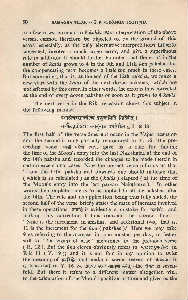Page 698 - Lokmanya Tilak Samagra (khand 2)
P. 698
50 SAMAGRA TILAK -- 2 • VEDANGA JYOTI~HA
in a few cases, be equal to 6 kalas. My interpretation of the above
verses, cannot, therefore, be objected to, on the ground of this
error, especially, as the only alternative interpretations hitherto
suggested, involve a much larger error, and give a superfluous
rule in addition. It should further be noted that the error in the
number of kalas grows to 4 in the 9th and 11th una pakshas for
the compensating term becomes a little too much in these cases.
But soon after, that is, at the end of the 12th paksha, we make a
new start with the kalas of the next dozen pakshas, which are
not affected by this error. In other words, the error is thus corrected
at the end of every dozen pakshas or soon as it grows to 4 kalas.
The next verse in the Rik recension closes this subject in
the following manner :-
~~~~)~>~ c:r~f4fct ~I
OlCl'~ls~: ~ ~ g II R 13 ..
The first half of the verse does "' not occur in the Yajus recension
and the second is only partially reproduced in Y. 16. The pre-
ceeding verse ~it +r~ etc., gave us a rule for finding
the time of the Moon's entry into the last Nak~:~hatra at the end of
the 14th paksha and recorded the changes to be made therein in
certain exceptional cases. Now the present verse informs us that
'from the 15th paksha and onwards one should indicate that
( which is so calculated ) as the ( kalas ) elapsed ( at the time of
the Moon's entry into the last parvan Nak~Jhatra ). ' In other
words the complete rule is to be applied to all the pakshas after
the 14th. The rule and its application being thus fully stated, the
second half of the verse briefly states the rates of increase involved
in these operations. ~ is evidently a mistake for ~; and
making this correction I thus translate the second line :-
' Nine is the increment in amshas, and additional two, that is,
11 is the increment for the una ( pakshas ).' Here we may take
9 as referring to the increase in solar amshas per day, or better
still to ' the group of nine ' mentioned in the previous verse
( R. 12 ). But the una eleven obviously refers to ~~.!llior: in
Rik 11 ( Y. 19 ); and it is not fair in my opinion to twist
the meaning of mcfiir and make it seven instead of eleven. It
is true that in Y. 16 we have a;if: ffi!~T +r~-the una is seven-
fold. But there it refers to a different matter altogether, viz .•
to the calculation of the Moon's position in time and gives us the

